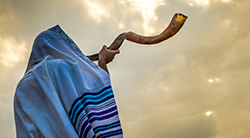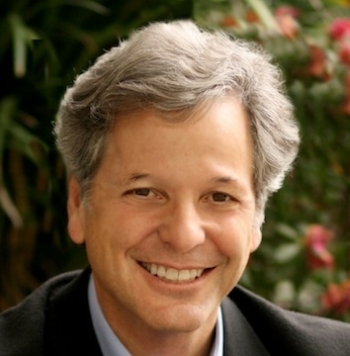 It's hard to imagine a writer who would dare to begin a book the way Numbers opens with Parashat B'midbar: four chapters loaded with technical details; names, flags, and the numbers of men in each tribe. It presents a challenge for clergy to carve out a sermon by mining for themes from this series of long technical lists.
It's hard to imagine a writer who would dare to begin a book the way Numbers opens with Parashat B'midbar: four chapters loaded with technical details; names, flags, and the numbers of men in each tribe. It presents a challenge for clergy to carve out a sermon by mining for themes from this series of long technical lists.
But there’s a list at the end of the first chapter that invites comment: it focuses on the Levites and their special role as the builders and porters of the Tabernacle:
"Do not on any account enroll the tribe of Levi or take a census of them with the Israelites. You shall put the Levites in charge of the Tabernacle of the Pact, all its furnishings, and everything that pertains to it… When the Tabernacle is to set out, the Levites shall take it down, and when the Tabernacle is to be pitched, the Levites shall set it up; any outsider who encroaches shall be put to death." (Num. 1:48-51)
The Torah emphasizes, time and again, that the main mission of the Levites is to follow orders:
"Do this with them, that they may live and not die when they approach the most sacred objects: let Aaron and his sons go in and assign each of them to his duties and to his porterage." (Num. 4:19)
As an example of the implications of disobedience, the narrative mentions the terrible end of Nadab and Abihu, the sons of Aaron:
But Nadab and Abihu died by the will of the Eternal, when they offered alien fire before the Eternal in the wilderness of Sinai; and they left no sons. (Num. 3:4)
Apparently, a tragic death teaches those left alive exactly which boundaries cannot be crossed! The biblical reminder of the death of Nadab and Abihu teaches the priests a most important and severe lesson: the essence of the priestly profession is obedience and exactness. Creativity, personal choice, and passion are an "alien fire" for the priests that results in the punishment of death.
On the other hand, a deep chasm separates Sages from the priestly edict. The culture of scholarly Rabbinic learning is the antithesis of the priestly culture. The Sage is both carnal and a creator whose honor is earned for his ability to change and innovate the words of the Torah, as well as the teachings of Sages who preceded him. Therefore, it is not surprising to discover several revealed and hidden struggles, several bed chambers poisoned with disdain-diluted anger, as the Sages discard the priestly culture.
Every line in the Talmud reveals the revolutionary character of the Sages. Here is one example about Rabbi Akiva that best illustrates their boldness: This is how, according to one tradition, Rabbi Akiva's career of learning began: "[Rabbi Akiva] went and sat before Rabbi Eliezer and before Rabbi Yehoshua. He said to them: 'My Masters open for me the taste of the Mishnah.' Once they told him one halachah, he went and sat by himself, contemplating: 'Why was this [letter] Aleph written; why was this (letter) Bet written; why was this thing said?' He went back and asked them and left them standing in silence." (Avot DeRabbi Natan 6:2)
This aggadah shouts out "radical." Rabbi Akiva, a serious Sage, is not satisfied with what his great masters teach him. Since his early steps as a student of the Sages, after every lesson he punctiliously reviewed the material taught, ready to raise every possible difficulty from his teachers' words, to return to them and "leave them standing in silence."
And if at first we fail to understand the significance of the subversion, it is restated even more sharply in the story of the stonecutter:
"Rabbi Shimon ben Elazar said, 'I will give a parable. To what is this matter similar? It is like a stonecutter who was chiseling away in the mountains. One time he took his pickaxe, sat upon a mountain, and began cutting away small pieces of stone. People came up to him and asked, 'What are you doing?' He replied, 'I am uprooting the mountain so I can throw it into the Jordan River.' They said, 'You will never be able to uproot the entire mountain.' The stonecutter continued until he came upon a large rock. He got underneath it, uprooted it and placed it in the Jordan. He said to the rock, 'Your place is not here (on the mountain), but here (in the river).' This is what Rabbi Akiva did to Rabbi Eliezer and Rabbi Yehoshua."
There is, according to Rabbi Shimon, some strange stonecutter whose every goal is to uproot an entire mountain and throw it in the Jordan River.
Why? Not because someone needs this act, but because he is a stonecutter and this is what stonecutters do. With great effort and thorough work, the stonecutter succeeds (he is, after all, Rabbi Akiva) and throws the entire mountain into the Jordan River. And what does this "mountain" represent? His master's teachings. This is the scholarly mission — to uproot that which previous generations proposed and offer fresh innovations. Is this process painful to the previous generations? Maybe. Does this disturb the confidence of some in the stability of the tradition? Apparently. But this is what scholars do.
In modern times, we can see such innovations in the numerous responsa put forth by Jewish authorities of various denominations, addressing topics that include everything from prayer to how we eat, work, love, and raise our families. Progressive rabbinic authorities continue to reinterpret Torah as new information emerges demanding a rethinking of previously established rabbinic guidelines about the law.
Sadly, Israel’s Orthodox Rabbinate would have us stop questioning and cease chiseling away at the mountain. Instead, they would have all Israeli Jews follow the Rabbinate’s dictates to the letter, like Levites performing their Temple duties. Israel’s Rabbinate fails to recognize that we are all theological descendants of Rabbi Akiva. By denying Israeli Jews the right to choose their own manner of Jewish practice, they rob the people of their scholarly and theological inheritance. What they miss is an enlightening and liberating truth — that the vitality, relevance, and ingenuity of our tradition depend on our ability to study, question, investigate, reinterpret, and innovate. This is the legacy handed down to us by the ancient Sages.
(This Torah reflection is partially based on a column written in Hebrew that was translated by Uzi Bar-Pinchas.)

Dr. Ruhama Weiss has it exactly right, not only in her understanding of the ongoing evolution of Judaism from biblical times to modernity, but also of the role that Jewish leadership has played often as “stonecutters” moving the rock of Jewish tradition from the mountain to the flowing river.
Recall Jacob wrestling with the human being/angel at the river and acquiring a new name Yisrael, “one who struggles and prevails.” Jacob was among the first in tradition who took history into his own hands and moved our understanding of ourselves in relationship with God and tradition forward, again with the river alongside him suggesting the ever-flowing movement of life and tradition.
Pirkei Avot (1:1) begins with the principle of evolutionary change carried forward through the generations: “Moses received the Torah from Sinai and conveyed it to Joshua; Joshua conveyed it to the Elders; the Elders to the Prophets; and the Prophets to the Men of the Great Assembly.” Pirkei Avot’s presumption is that Torah flows through every generation, and each reviews and reenvisions what it receives, thus giving Judaism contemporary meaning. The renewal of tradition is radical because every generation frees itself from the past while creating its own future.
Dr. Weiss’s understanding of Rabbi Akiva’s “radical” departure from what he received lays the groundwork for the emergence of Zionism in our era. From Herzl and Political Zionism to Ahad Ha’am and Cultural Zionism to Kook and Religious Zionism to Ben Gurion and Labor Zionism to Jabotinsky and Revisionist Zionism and from Orthodox Religious Zionism to Reform and Progressive Zionism, each Zionist stream expresses a new vision of the Jewish people in the Jewish State.
Israel’s Declaration of Independence, too, expresses a radically new Jewish self-perception in tune with contemporary Jewish liberal religious and democratic values. There it says that Israel is to be founded “on freedom, justice and peace as envisaged by the prophets of Israel; … to ensure complete equality of social and political rights to all its inhabitants irrespective of religion, race or sex; ….to guarantee freedom of religion, conscience, language, education and culture.”
Israel could never have been established had Judaism not been open to radical evolution and Jews not taken history into their own hands to recreate themselves and Judaism anew.
Rabbi Jacob Weinstein, a past President of the CCAR, wrote: “Israel is the permanent underground, the eternal yeast, the perennial Elijah spirit, ever willing to plough the cake of custom, to put rollers under thrones, and give a day-to-day lease to authority. Anchored to Torah, rooted to God, Israel feels free to dispense with [hu]man-made hierarchies. ... ” (The Place of Understanding [New York: Bloch, 1959], p. 39).
Reform and Progressive Zionism is at once the mainstream in contemporary Jewish history and reflective of the radical transformation of tradition as articulated in the texts cited by Dr. Weiss and Israel’s own Declaration of Independence.
B’midbar, Numbers 1:1−4:20
The Torah: A Modern Commentary, pp. 1,028−1,043; Revised Edition, pp. 897−916
The Torah: A Women’s Commentary, pp. 787–814
Haftarah, Hosea 2:1–22
The Torah: A Modern Commentary, pp. 1,252−1,255; Revised Edition, pp. 917−920

